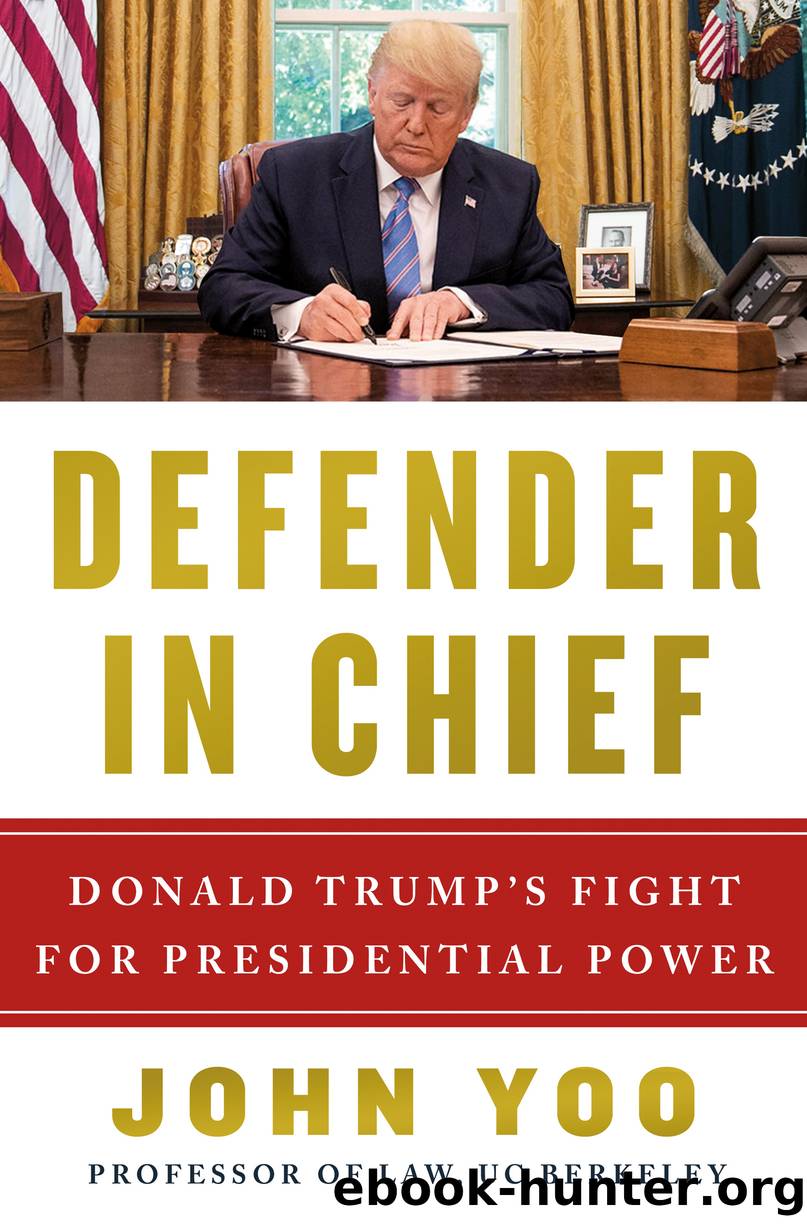Defender in Chief by John Yoo

Author:John Yoo
Language: eng
Format: epub, azw3
Publisher: St. Martin's Publishing Group
IV.
President Trump has succeeded in advancing his foreign policy because he has not needed the cooperation of the other branches. Trump is not building a new international order along the lines of NATO at the beginning of the Cold War. Rather, he is seeking to undo the entanglements of his predecessors. Unraveling foreign commitments requires no legislative consent. Even though the constitutional text remains silent, the best reading of the constitutional structure recognizes an executive ability to terminate treaties without congressional approval. But the president’s power goes beyond the ability to terminate existing commitments. The president virtually enjoys an absolute veto over efforts to create new ones. By exercising both the power to end and the power not to begin, Trump has advanced his foreign policy agenda to reduce America’s engagements abroad. His right to terminate agreements draws from the same constitutional roots as his authority to set foreign policy.
Since entering office, Trump has gone on a frenzy of agreement breaking. On May 8, 2018, the Trump administration announced that the U.S. would withdraw from the Joint Comprehensive Plan of Action, otherwise known as the Iran nuclear deal. Agreed upon by the United States, Iran, Russia, China, the United Kingdom, France, and Germany in 2015, the JCPOA required Iran to limit its nuclear energy research in exchange for a financial payment and the lifting of economic sanctions. Due to sharp political opposition in Congress, the Obama administration chose not to submit the JCPOA as a treaty or even as a congressional-executive agreement enacted by a statute. This made it all the easier for President Trump, once in office, to simply reverse Obama’s unilateral policy. Declaring the agreement “one of the worst and most one-sided transactions the United States has ever entered into,” Trump terminated the agreement despite the contrary advice of former secretary of defense Jim Mattis, former secretary of state Rex Tillerson, and our major NATO allies. Trump replaced the JCPOA with the restoration of tough economic sanctions on Tehran.79 The president argued that Iran had failed to live up to its promises to disclose and end its nuclear weapons activity and that it had used the economic benefits of the deal to fund terrorism and aggression.
Obama’s other landmark foreign policy achievement, a global agreement to reduce greenhouse gases, met a similar fate. Signed by the United States and 187 other nations in 2016, the United Nations Framework Convention on Climate Change (known popularly as the Paris Agreement) had committed nations to reduce their carbon emissions in an effort to slow global warming.80 As with the JCPOA, political controversy erupted over limiting U.S. economic activity and energy usage while China and India had taken on less demanding obligations. The Obama administration responded by not submitting the Paris Agreement for approval as a treaty or a statute. And as with the JCPOA, this lack of congressional support then gave Trump an opportunity to fulfill another campaign pledge. On June 1, 2017, President Trump announced that the United States would withdraw from the Paris Agreement.
Download
This site does not store any files on its server. We only index and link to content provided by other sites. Please contact the content providers to delete copyright contents if any and email us, we'll remove relevant links or contents immediately.
Conversations with RBG by Jeffrey Rosen(732)
Genetics by Unknown(723)
The Tyranny of Good Intentions by Paul Craig Roberts(664)
Journalism by Michael Schudson(572)
Critical Race Theory by Richard Delgado & Jean Stefancic & Angela Harris(537)
Losing the News by Jones Alex(518)
The Permission Society by Timothy Sandefur(507)
Talking Back to the Indian Act by Mary-Ellen Kelm(506)
Active Liberty by Stephen Breyer(506)
The Federalist papers by Alexander Hamilton; James Madison; John Jay; Lawrence Goldman(496)
Supreme Power by Ted Stewart(493)
The Jury in America by Dennis Hale(488)
American Studies by Deloria Philip J(486)
Information Privacy Law by Daniel J. Solove Paul M. Schwartz(480)
The Conscience of the Constitution: The Declaration of Independence and the Right to Liberty Hardcover by Timothy Sandefur(474)
A Case for the American People by Norman Eisen(473)
We the People by Sachs Albie(455)
The Constitutional Convention by James Madison(453)
Supreme Inequality by Adam Cohen(452)
